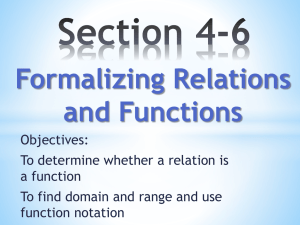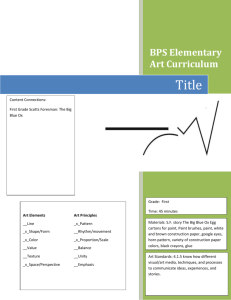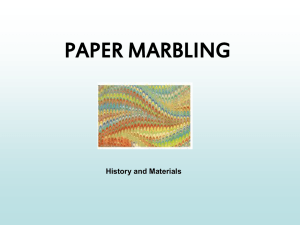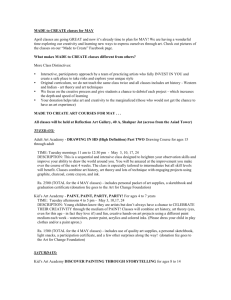File - Alexander Rolling
advertisement
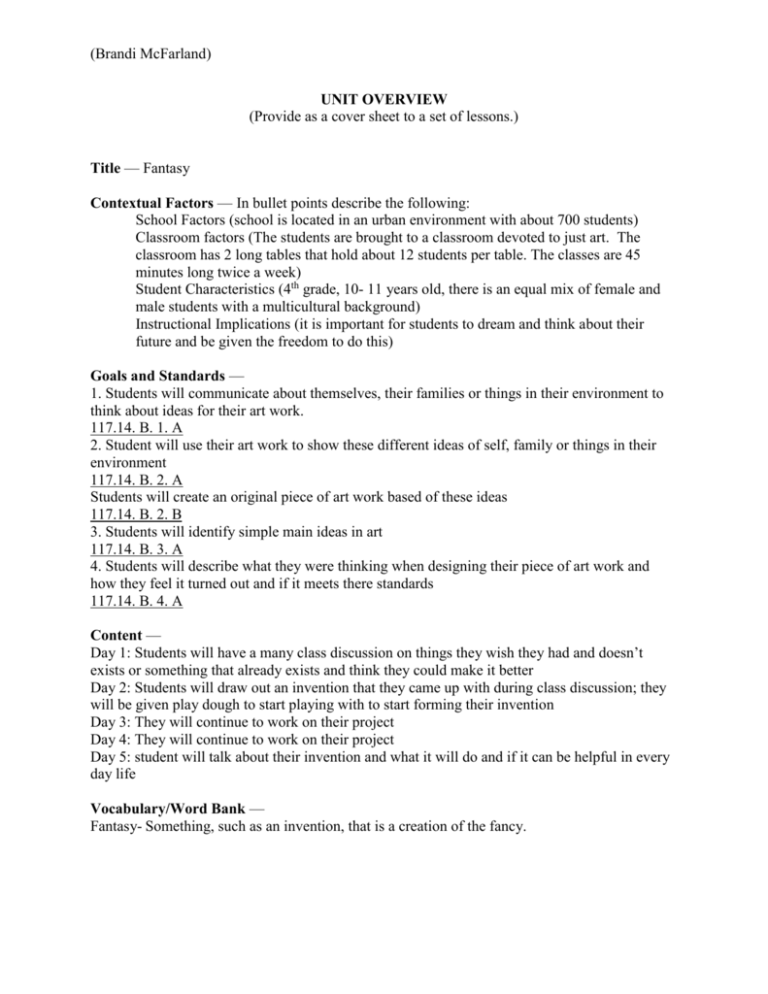
(Brandi McFarland) UNIT OVERVIEW (Provide as a cover sheet to a set of lessons.) Title — Fantasy Contextual Factors — In bullet points describe the following: School Factors (school is located in an urban environment with about 700 students) Classroom factors (The students are brought to a classroom devoted to just art. The classroom has 2 long tables that hold about 12 students per table. The classes are 45 minutes long twice a week) Student Characteristics (4th grade, 10- 11 years old, there is an equal mix of female and male students with a multicultural background) Instructional Implications (it is important for students to dream and think about their future and be given the freedom to do this) Goals and Standards — 1. Students will communicate about themselves, their families or things in their environment to think about ideas for their art work. 117.14. B. 1. A 2. Student will use their art work to show these different ideas of self, family or things in their environment 117.14. B. 2. A Students will create an original piece of art work based of these ideas 117.14. B. 2. B 3. Students will identify simple main ideas in art 117.14. B. 3. A 4. Students will describe what they were thinking when designing their piece of art work and how they feel it turned out and if it meets there standards 117.14. B. 4. A Content — Day 1: Students will have a many class discussion on things they wish they had and doesn’t exists or something that already exists and think they could make it better Day 2: Students will draw out an invention that they came up with during class discussion; they will be given play dough to start playing with to start forming their invention Day 3: They will continue to work on their project Day 4: They will continue to work on their project Day 5: student will talk about their invention and what it will do and if it can be helpful in every day life Vocabulary/Word Bank — Fantasy- Something, such as an invention, that is a creation of the fancy. (Brandi McFarland) Materials/Resources/Technology — List the necessary materials and resources that will be used to teach this unit including technology. Artists/artworks (Untitled #1 by Amy Podmore squats between Broadway and James) Teacher resources: computer, projector, Student materials and tools: ruler, play dough, paper, pencils, markers Summative Assessment Plan — 1. Did students communicate things about themselves, family, or their environment? 1 2 3 4 5 6 7 8 9 10 2. Did the student use these ideas of self, family or their environment in their art work? 1 2 3 4 5 6 7 8 9 10 3. Did the student create an original piece of art work? 1 2 3 4 5 6 7 8 9 10 4. Was the student able to identify the main ideas of art work? 1 2 3 4 5 6 7 8 9 10 5. Did the student talk about their art work and the idea behind it? 1 2 3 4 5 6 7 8 9 10 (Brandi McFarland) SCOPE OF THE INSTRUCTIONAL PLAN Painting day Lesson Title — Painting sculpture Day — 4 of 5. Objectives/Assessments/Adaptations — students will paint their dried sculptures in a variety of colors. Objective Assessments Format of Assessment Objective 1: Students will paint tier sculptures in acrylic paint. Pre-assessment Teacher discussion of the use of acrylic paint and the rules for use of the paint. Adaptations Art Standard: 117.14. B. 2. A Formative Assessment Students will create an original piece of art work based of these ideas Teacher walks around and checks up on each student. Lesson Body Anticipatory Set — State how you will gain student attention, what the purpose of the lesson, and why. This introduction must be motivational. Procedures — 1. Set up paint and dried sculptures for students( five minutes) 2. Teacher discussion of acrylic paint and the rules for the paint in the classroom( five minutes) 3. Student painting of their sculptures ( twenty five minutes) Clean-up — Clean up paint and have the students wash their hands before next class. Also set sculptures on shelf to dry (ten minutes) Independent Practice — N/A Safety Considerations — (Brandi McFarland) SCOPE OF THE INSTRUCTIONAL PLAN Critique day Lesson Title — Painting sculpture and critique Day — 5 of 5. Objectives/Assessments/Adaptations — students will finish painting their dried sculptures and participate in a class discussion of their work. Objective Assessments Format of Assessment Objective 1: Students will paint tier sculptures in acrylic paint. Pre-assessment Teacher discussion of the use of acrylic paint and the rules for use of the paint. Formative Assessment Teacher walks around and checks up on each student. Pre-assessment Teacher will go over what is good to talk about during critique. Teacher will ask question to the students to explain their work and why they did what they did. Adaptations Art Standard: 117.14. B. 2. A Students will create an original piece of art work based of these ideas Objective:2 Students will participate in a class discussion of their work Art Standard: 117.14. B. 4. A Students will describe what they were thinking when designing their piece of art work and how they feel it turned out and if it meets there standards Formative assessment Lesson Body Anticipatory Set — State how you will gain student attention, what the purpose of the lesson, and why. This introduction must be motivational. Procedures — 1. Set up paint and dried sculptures for students( five minutes) 2. Teacher discussion of acrylic paint and the rules for the paint in the classroom( five minutes) 3. Student painting of their sculptures ( ten minutes) 4. Students will participate in a critique and where the teacher will ask question about the students work. (fifteen minutes) Clean-up — Clean up paint and have the student wash hands before next class. Also set sculptures on shelf to dry (ten minutes) (Brandi McFarland) Independent Practice — N/A Safety Considerations — APPENDIX (Attach to the end of the unit as needed.) Rubric — Evaluation of student performance based on unit goals. Supplemental Instructional Tools — Test, quizzes, worksheets, etc. Self-reflection — After teaching the lesson, assess student achievement with the intended goals and objectives. Describe the evidence. Explain the strengths and weaknesses including was to improve the unit.




